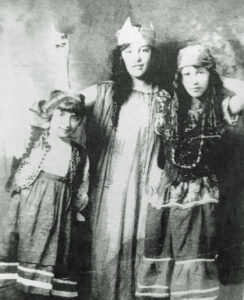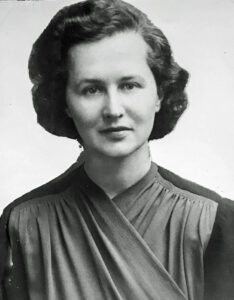True Tales from Canton’s Past: Zeppa’s Story
By George T. Comeau“Americans are not a narrow tribe,” wrote Herman Melville. “Our blood is as the flood of the Amazon, made up of a thousand noble currents all pouring into one.” We are a nation of immigrants and throughout Canton’s history there have been countless stories that share the tale of coming to America. There is a beautiful story that this author recently happened upon that aptly defines the strength of the immigrant experience in bold colors across the span of a century.

In Boston, the three Shlifer sisters in 1920 in a photo taken during Purim (Courtesy of Helena Levine-Ryan)
In a faraway village called Berdichev, a tiny shtetl in the Ukraine, there lived a family by the name of Shlifer. In 1912, the early stages of the “Red Terror” had commenced. The winds of Ukrainian nationalism had begun to blow and the Jews of Berdichev were increasingly under attack. A young Zeppa Shlifer, merely 6 years old, had gauzy memories that she would recount decades later. “It was the day of the pogrom … there came the frightening early morning knock on the door. It was a stranger with a white face who came to warn us and all our neighbors that the Monjiks were on a rampage, and to keep our doors barred and not stir from the house.”
The description of that day is chilling, and transforms the reader to a terrible time when Jews were persecuted and killed for their religious beliefs. “We remained in the deafening silence of our house … I remember my mother’s face as she gathered us to her and bade us pray silently. I do not know how long we remained in this position, but I still remember the clasp of my mother’s hand on my shoulders.” They remained silent in that house for over eight hours. When it was over, Zeppa’s grandfather was dead — murdered in his shop. The dark story continued, “We met friends and relations, terrified and angry, bringing news of this one maimed or murdered, of households destroyed and pillaged. It was now dusk and we ran with all our might. What a sight confronted us! Here in the marketplace they had done their worst. The stalls and shops were in ruins, and all who could, helped each other.”
The family immediately made plans to escape to another world. It must have been like a nightmare. Zeppa described the trek in a series of short stories written in a manner that only one who has experienced the darkest of days can describe. “It is a dark night and strings of people are walking in silence before you. Your mother holds your sister’s hand on one side and your brother’s hand on the other. You are instructed to follow behind as closely as possible. But before you, besides the struggle of people, is a large orange moon, hanging low and straggling with you. You are captivated.” Through the eyes of this child, we are transported into the struggle for survival and a better life.
The family fled through Germany to Hamburg, where, on November 6, 1912, they sailed to Liverpool, England. “You see the most of the people lying in their chairs or in their beds,” recalled Zeppa. “They are seasick, unable to eat, asking for water.” Six days later, they boarded the S.S. Franconia bound for Boston and a new life. Some relatives had already arrived, and in short order they began to make a living. The Shlifer family found lodgings in the tenement district of the South End. Eventually, Juluis, Zeppa’s father, got work as a tinsmith, and over time became a tailor. Zeppa had other plans. A beautiful and bright woman, Zeppa changed her name to a more in-vogue first name of Sylvia and by the late 1920s was able to attend Radcliffe College.
Sylvia had an amazing life and her passion was writing. Sylvia’s daughter, Helena Levine-Ryan, lives at Rubin Court here in Canton. Also an accomplished writer, Helena is a charming woman with a keen sense of family. When asked about her mom’s life, she explained that, “My mother had a desire to learn and become educated. She was so talented and ran from one thing to another.” The immigrant tale is only one aspect of Sylvia’s life. The family was multigenerational. The grandmother of the family that was ever present and beautiful in youth and generous in old age. “I can recall that small apartment in Dorchester,” said Helena. “My grandmother seemed to make everything — butter, cheese and bread.” In fact, the grandmother played a large role in helping raise her own granddaughter.
The family worked a series of small businesses and possessed a “courage beyond belief.” The revolutionary spirit was deeply ingrained in this family, and Sylvia had it in spades. Paying her way through college meant a job at the Boston Public Library. In 1927, Sylvia was in Manhattan and met Moe Seligman and in December they married. What was seen as an impetuous youthful dalliance seems to have ended in divorce, or perhaps separation. The story is not quite clear.
In 1939, Sylvia worked as part of the Works Progress Administration (WPA) and helped to research the seminal book American Portraits, 1620-1825, Found in Massachusetts. By the time World War II began, Sylvia travelled to St. John’s, Newfoundland.
During the war, Newfoundland was viewed not only as Canada’s “first line of defense,” but actually “the key to the western defense system.” Within a very short time, Newfoundland boasted five military and civilian aerodromes, two naval bases, two seaplane bases, plus five army bases, and tens of thousands of Canadian and American military personnel were posted throughout Newfoundland and in Labrador. Sylvia found herself assigned to the government secretarial pool. And that is when she met Leo Levine.
Leo had an amazing story of his own to tell. The pair met in an art gallery, and Leo saw the most beautiful woman he had ever set eyes upon. Sylvia, likely self-assured, told of her Russian ancestry and her own escape from near death. Leo had a similar story, a Latvian Jew who too had escaped death at the hands of the Nazis. In 1938 he was in Berlin, and then was in Brazil as a journalist. In 1939 he was in England, assisting with intelligence, and emigrated to the United States in 1940. When he met Sylvia, he was a war correspondent employed by the St. John’s Telegram. Sylvia and Leo married in 1943 and they moved to Boston.
Eventually the family settled in Sharon and lived there for quite some time. After a brief move to Newton, Leo and Sylvia decided to return to the close company of friends and moved to Canton — settling in on Kings Road. Helena recalls that her mother was an “extremely smart woman,” adding that “she was so kind to all, and if you needed her, she was there.” Sylvia wrote beautifully, and her immigrant story is the stuff of movies. Helena has self-published three books all centered on the stories of her family. Later in her life, here in Canton, Sylvia joined the First Parish Church. Although raised in the Jewish faith, it seems that Sylvia found her place in the philosophy of Unitarianism. It makes sense for a woman that was guided by the principles of service and giving to others. The Unitarian movement proclaims the importance of individual freedom of belief, and it includes members from a wide spectrum of beliefs, and it is not a surprise that Sylvia felt at home in the congregation here in Canton.
Leo Levine died in Canton in 1980. Helena shared that the death “hit her mother like a storm, and she was quite depressed at the loss.” Sylvia Levine died in 1995 at age 89. Last week a friend gave this author a small book entitled Another Spring – Stories and Vignettes by Sylvia Levine. The book was dedicated to the memory of Sylvia’s husband. And inside the first pages are a quote by Walt Whitman, “I believe a leaf of grass is no less than the journeywork of the stars.” The grass is made up of the same atoms that once were packed together with the atoms that now form constellations. That leaf of grass, like each of us — is in fact simply part of a constellation. Sylvia Levine is one of those stars far overhead, with a beautiful story of survival and the American experience.
Special thanks to Helena Levine-Ryan and Allan Keith for sharing their stories connected to Sylvia Levine.
Short URL: https://www.thecantoncitizen.com/?p=71571











